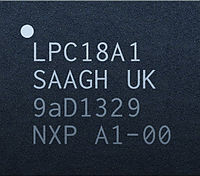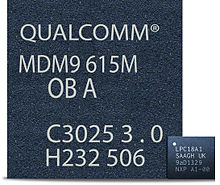Apple M7
| Apple M7 | |
|---|---|
 The M7 coprocessor NXP LPC18A1 |
|
| Production: | since September 2013 |
| Producer: | NXP Semiconductors |
| Processor clock: | 150 MHz |
| Instruction set : | Thumb |
| Microarchitecture : | Cortex-M3 |
| Name of the processor core: | ARM Cortex-M3 |
The Apple M7 is a coprocessor for sensor data acquisition from the US company Apple Inc. It can acquire and process data from various motion sensors of a mobile device in a power-saving manner and independently of a main CPU .
function
The M7 can record, process and temporarily store the data from the motion sensors, even when the entire device is in a power-saving idle state. User programs can then query this data at a later point in time. This reduces the average power consumption and extends the battery life.
The data preparation also provides information about the type of movement, such as walking, running or driving.
technology
The chip with the code name Oscar works with an ARM Cortex-M3 -CPU. It is based on a microcontroller from the Dutch semiconductor manufacturer NXP Semiconductors and is called LPC18A1 .
Use in Apple devices
The processor is used in Apple's iPhone 5s smartphone , the iPad Air and the iPad mini 2, where it handles most of the sensor data acquisition and processing for the Apple A7 CPU.
For this device, it was provided with a customer-specific BGA housing with 30 connections and an adapted name. The smartphone uses an accelerometer , gyroscope and compass connected to the M7.
Applications communicate with the chip via a so-called Core Motion API of the iOS 7 operating system . This allows, for example Fitness - Apps to track the user's movements and track.
relevance
With the introduction of the A7 SoC, Apple specifically advertised another chip on the logic board of an iOS device for the first time . Even before the introduction of the M7, iOS devices had already built in motion coprocessors, for example since the first iPhone for a tilt sensor, since the iPhone 3GS for a magnetometer and since the iPhone 4 for a gyroscope. However, the control processors of these sensors were not combined on one chip and, like the M7 in standby of the iPhone, did not have the option of collecting data in the background and relieving the CPU . Compared to other chips besides the Samsung SoCs, the M7 is less relevant for the correct operation of the iPhone. The Qualcomm baseband processor, for example, which is responsible for telephony and the Internet connection, far surpasses the M7 in terms of complexity and chip size and, due to its function, is the most important chip in an iOS device with a modem after the SoC .
Web links
- Activity detection - Apple iPhone 5s with M7 motion processor (mechlab-engineering.de/)
Individual evidence
- ↑ a b c Jason Tanner, Jim Morrison, Dick James, Ray Fontaine, Phil Gamache: Inside the iPhone 5s . Chipworks. September 20, 2013. Archived from the original on August 3, 2014. Info: The archive link was inserted automatically and has not yet been checked. Please check the original and archive link according to the instructions and then remove this notice. Retrieved September 20, 2013.
- ↑ a b NXP 150 MHz, 32-bit Cortex-M3 microcontrollers LPC1800 (PDF; 281 kB) NXP Semiconductors. September 2010. Retrieved September 20, 2013.
- ↑ Anand Lal Shimpi: The iPhone 5s Review: M7 Motion Coprocessor . AnandTech. September 17, 2013. Retrieved September 18, 2013.
- ↑ Mel Martin: The iPhone's M7 Motion coprocessor and Maps . TUAW. September 12, 2013. Retrieved September 13, 2013.
- ↑ Alex Colon: Apple's M7 coprocessor might bring big improvements to its mapping abilities . GigaOM. September 12, 2013. Retrieved September 13, 2013.
- ↑ Chris Burns: iPhone 5S Apple M7 coprocessor "knows" when you are sleeping . SlashGear. September 12, 2013. Retrieved September 13, 2013.
- ↑ Computerbase - Co-processor saves seven days of sensor data - Apple M7 significantly reduces power consumption , accessed on March 24, 2014
- ↑ Adam Clark Estes: How Apple's M7 Chip Makes the iPhone 5S the Ultimate Tracking Device . Gizmodo. September 10, 2013. Retrieved September 13, 2013.
- ↑ Husain Sumra: iPhone 5s Includes New 'M7' Motion Coprocessor for Health and Fitness Tracking . MacRumors. September 10, 2013. Retrieved September 13, 2013.

